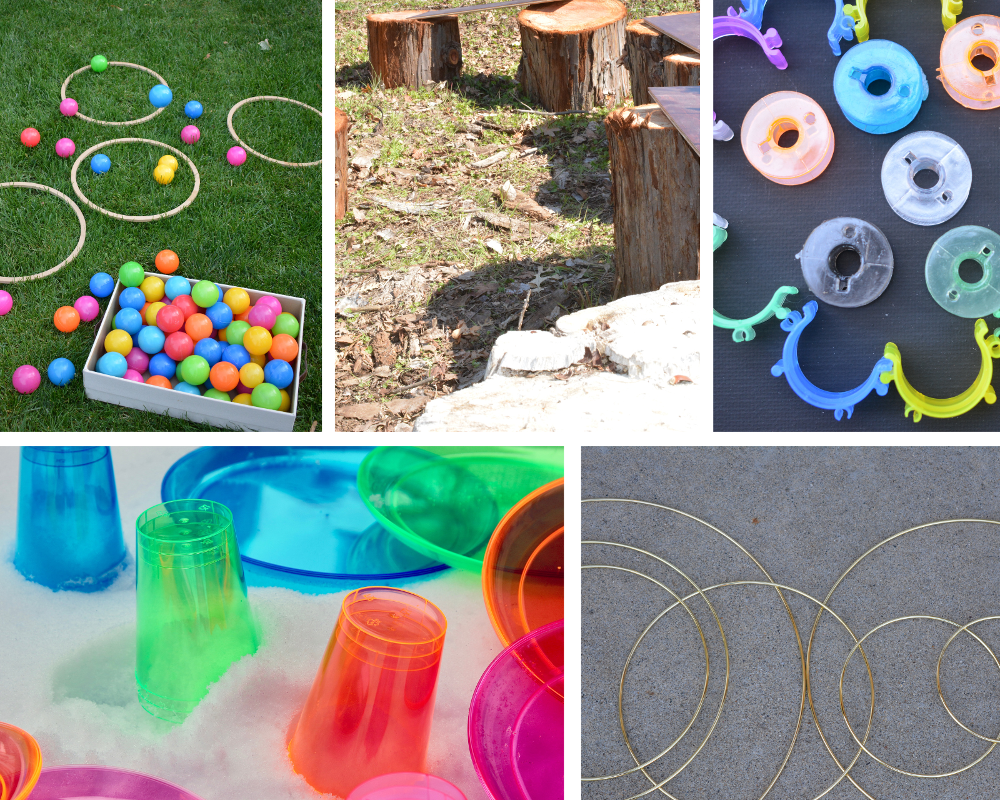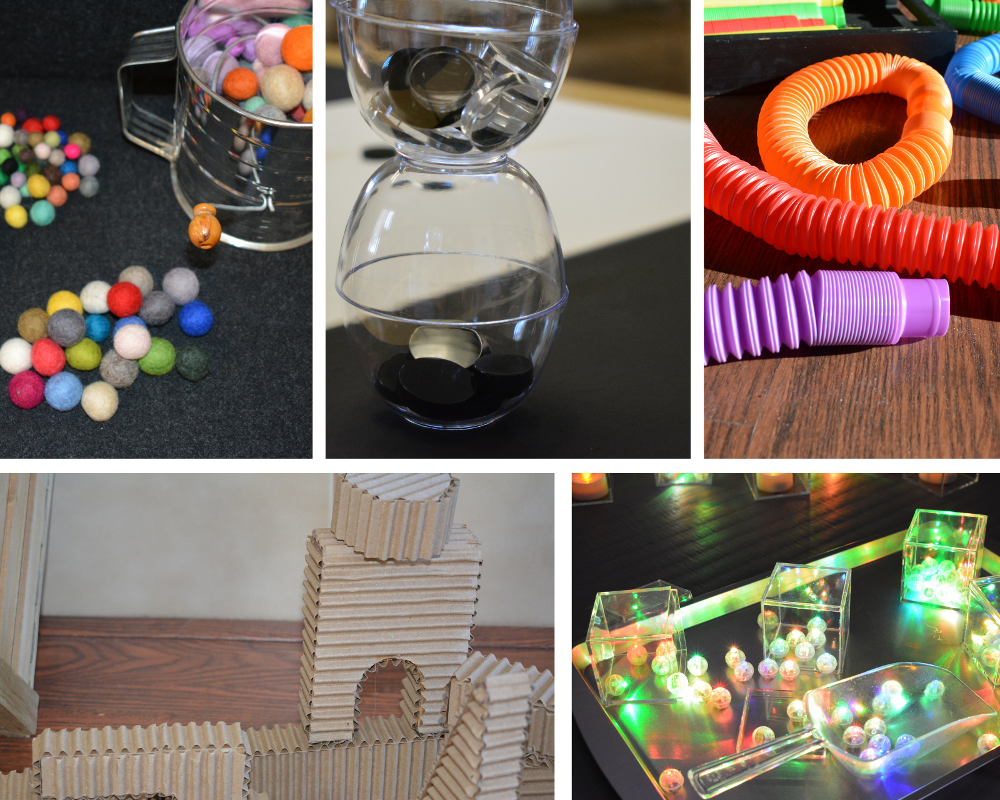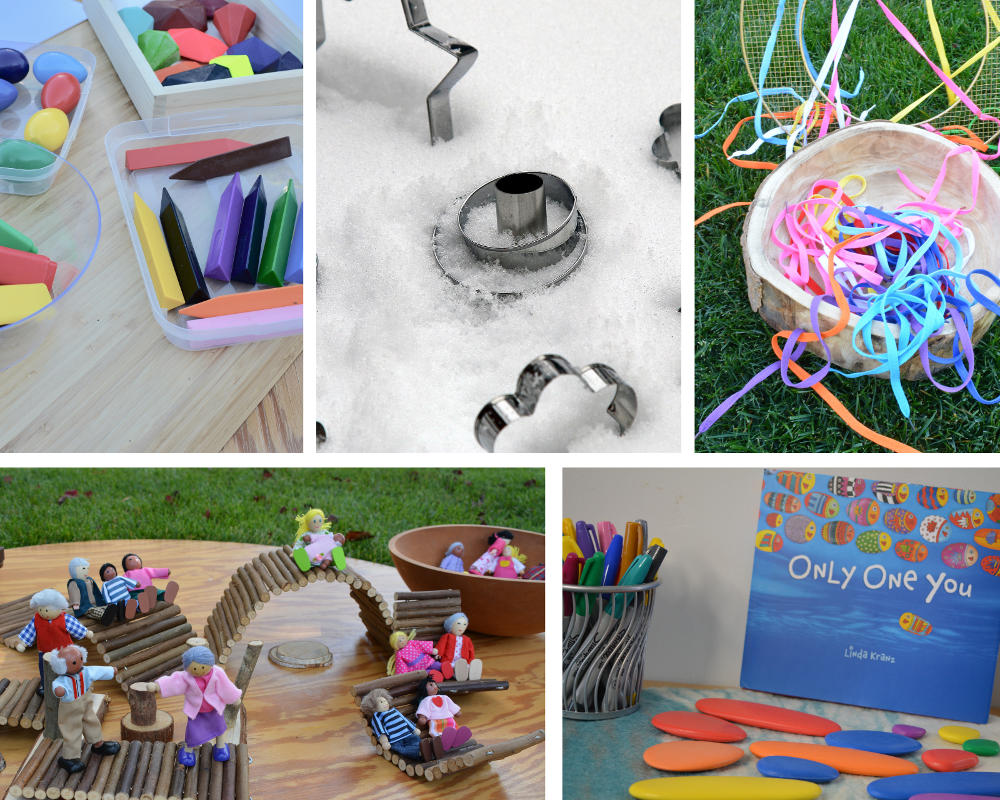Infusing Loose Parts play presents a beautiful opportunity to support children with diverse abilities. This approach reshapes learning ecosystems and offers new avenues for creative growth, engagement, and learning for all children.
Each child’s individual experience is as unique as their abilities. Children with diverse abilities require learning ecosystems responsive to their distinct ways of engaging with the world. The Loose Parts educational philosophy is among the most compelling approaches that honor diversity and create inclusion.
The Loose Parts Educational Philosophy
The Loose Parts educational philosophy focuses on the actions children provoke when they interact with unscripted, undefined, unpredictable, upcycled, unexpected, unconventional, and unique materials. Children move, carry, combine, design, line up, connect, and disconnect the Loose Parts in multiple ways. Loose Parts are materials with no specific directions that can be used alone or combined with other educational media. They can be natural or synthetic, including wooden blocks, buttons, fabric pieces, stones, pine cones, and containers.
The Benefits of Loose Parts Play for Children with Diverse Abilities
Loose Parts play gives children flexibility and freedom to express creativity and build problem-solving skills. For children with diverse abilities, these materials become tools for communicating and interacting with their peers without the constraints of ‘right’ or ‘wrong’ methods of play.
Here are several benefits of incorporating Loose Parts play into learning environments:
1. Promotes Sensory Exploration
Children with sensory processing difficulties or those on the autism spectrum often find solace and expression through tactile experiences. Loose parts provide an array of textures, weights, sizes, and colors to explore.
2. Encourages Fine and Gross Motor Skill Development
Manipulating loose parts can help develop fine motor skills, while larger objects can help hone gross motor abilities, which is crucial for kids with physical disabilities or developmental delays.
3. Fosters Communication and Social Skills
By providing a shared resource without rigid rules, loose parts can serve as a medium for children to express themselves and interact with others, enhancing verbal and non-verbal communication.
4. Offers Inclusive Learning Opportunities
Loose parts play levels the playing field, allowing children with varying abilities to participate in a way that is comfortable and meaningful to them.
5. Supports Cognitive and Creative Processes
This type of play stimulates questioning and experimenting and triggers imaginative thought processes, which can be especially beneficial for children who learn and express themselves in non-traditional ways.
Strategies for Implementing Loose Parts Play
Engaging the Body
Early childhood educators have long known that children learn by moving their bodies. In The Secret of Childhood, Maria Montessori highlighted the connection between the mind and the body. She argued that movement and physical activity are essential to intellectual growth. Through movement, we encounter external reality.
Through these contacts, we eventually acquire abstract ideas (Montessori and Carter 2019). In Waldorf education, the concept of Eurythmy, a system of harmonious body movement to the rhythm of music and spoken words, is central to the curriculum. Eurythmy began as performance art to make music and speech visible in artistic form. It is another language that allows children with diverse abilities to express what they want, need, know, and desire, making their thinking and ideas visible.
Early childhood ecosystems need to offer a variety of sensory integration activities that strengthen children’s fine motor movement, encourage visual and motor abilities, increase balance, promote muscle tone, and enhance the proprioceptive and vestibular systems. They also must promote social and emotional development. By knowing the importance of movement, educators can design ecosystems that encourage movement for all children, including children with diverse abilities.
Movement and Loose Parts play belong together. Using Loose Parts play to engage the body gives children with diverse abilities complete control of their learning and capacities.
Ideas to Engage the Body

- Metal circles encourage gross motor skills as children with diverse abilities design artful arrangements while investigating mathematical concepts like seriation and spatial relationships. For children who use a wheelchair or work best upright, you may offer pegboards on a wall or a large vertical surface such as a fence for arranging or suspending the circles.
- Let the children’s imaginations run wild as they transform logs, branches, and sticks into pretend campfires, hideaway spots, or obstacle courses. Provide handled baskets for gathering the natural materials.
- Children use their entire bodies to move, climb, and jump on tree stumps. Adjust the size and weight of the stumps to make an appropriate challenge for children with diverse abilities.
- Offer wider tongs, such as mini metal strawberry tongs or easy-to-squeeze plastic tongs, which may make it easier to pick up materials. Even using fingers to transport items greatly benefits fine motor skills. Use small tins or other containers when mini zip bags are challenging to open.
- Scooping, digging, piling, and forming structures in the snow using cups, plates, and hands engages children’s core muscles and extremities to develop whole-body strength and promotes bilateral skills.
- Add a new challenge for children with advanced fine motor abilities. Lightweight plastic bobbins and accessories require great precision to manipulate and balance.
Engaging the Senses
Sight, touch, hearing, and smell are integral to our memories. Our senses create feelings of belonging and comfort. When we cook and bake foods from our childhood, we engage in the sense of smell and bring up memories. When we look at the colors of a work of art, we are not only using our sight and vision but also awakening our emotions and perceptions surrounding the art, which may inspire or repulse us.
When we touch fabric at a store, we are testing how it will feel next to our bodies—will it be scratchy or soft? When we hear a musical symphony or the rain hitting our window, we react differently based on our experiences. Also, consider the proprioceptive system in our muscles and joints, which helps develop body awareness and serves as a regulatory system that assists in controlling responses to stimuli. The proprioceptive system can help calm children with diverse abilities overwhelmed by stimulation. It can also alert children who need increased sensory stimulation to focus their attention on their play or exploration.
Stimulating the senses is enjoyable while also strengthening connections in the brain to enhance learning. Carefully curated Loose Parts engage children with diverse abilities in using their senses, stimulating sensory perception, and helping them develop their powers of sensory discrimination.
Ideas to Engage the Senses

- Multi-sized felted balls promote sensory exploration and visual discrimination. These felted Loose Parts are aesthetically inviting and offer a soft, rich feel for children with diverse abilities seeking tactile input or developing greater tolerance for different textures.
- Scooping mini lights into clear boxes promotes visual attention and motor skills and is an exciting way for children to explore light and dark. Light and color exploration can offer a brain break for children with diverse abilities seeking additional visual input to support regulation.
- Black and white canvases and acrylic pieces call attention to contrast, making this an appropriate exploration for children with diverse abilities who see only specific colors or have decreased vision. It also supports visual-spatial skills as children use the containers to create and fill vessels of space and form creative visual designs.
- Corrugation adds texture for increased sensory input. Combined with braille blocks, these cardboard blocks are appropriate for exploring typically developing children with diverse sight and vision abilities.
- Filling jars and tubes with colorful abalone pieces, sand, and rocks create abundant sounds. Try incorporating fillings of different textures and combining the containers with other Loose Parts as a motivating way to develop bilateral movement.
- Pots, pans, spoons, balls, and corrugated metal items are good for rubbing or banging to create sounds and vibrations. Children with diverse abilities can feel the vibration through a whisk as it strikes the metal materials.
Engaging Wonder and Curiosity
Curiosity is the gift and pleasure of knowing or learning something new. Wonder is that ongoing sense of surprise that keeps us researching, exploring, and learning. Children’s sense of wonder and intense curiosity leads them to pursue answers relentlessly. Children want to know, to see, and to experience new things. Curiosity is the recognition, pursuit, and intense desire to explore novel, challenging, and unknown adventures. The brain’s chemistry changes when we become curious, helping us understand and retain information. Curiosity prepares the brain for learning, becoming a fast-moving, information-gathering machine that encourages further wonderment and knowledge.
Curiosity is a fundamental human impulse; education must be rooted in this behavior. Cultivating childhood wonder and joy requires educators to do less of what doesn’t matter and more of what does. Constantly pushing children with diverse abilities to do more or encounter overly daunting challenges can lead them to lose their sense of wonder.
Loose Parts provides children with diverse abilities with novelty, multiple affordances, and ways to explore, putting children in charge of satisfying their curiosity while eliciting wonder. Curiosity motivates children to act and think in new ways, investigate, be immersed, and learn about their immediate target’s qualities. It is a vital, motivating aspect of learning and knowledge gathering. For example, Raul, who is four years old and has experienced some neurodiversity challenges, is incredibly curious about water quality.
He plays at the water table and enjoys pouring water from one container to another. His curiosity sparks him to ask questions: “What makes water? What floats and what sinks in the water? What happens to water when it is cold or hot?” This intense curiosity leads Annette, the educator, to bring Raul ice cubes. On the first day, she makes the ice cubes with water and adds liquid watercolor. She gives Raul time to explore the ice cubes, which hold Raul’s curiosity for a while.
As Raul continues to ask questions, Annette adds flashlights to explore the ice cubes’ transparency and color. She makes more ice cubes, this time freezing colorful silicone beads inside the cubes. Raul watches as the sun melts the cubes and asks many questions: “How long will it take? What happens to the beads? Will they also melt?” Annette invites other children to join, and together, they write their questions and responses. Raul feels welcomed and enjoys the conversations with other children.
Ideas to Engage Wonder and Curiosity

- Add cork blocks of various shapes and sizes to support wonderment as children explore weight, balance, and space. Cork blocks fall quietly, making them a great choice for children adapting to auditory stimulation.
- The more affordances a Loose Part has, the more opportunities there are for wonder and experimentation. Children with diverse abilities practice attention, planning, organization, prioritization, and self-monitoring skills by turning simple, colorful tubes into designs, chutes, tracks, hoops, games, and more!
- The more affordances a Loose Part has, the more opportunities there are for wonder and experimentation. Children practice attention, planning, organization, prioritization, and self-monitoring skills by turning simple, colorful tubes into designs, chutes, tracks, hoops, games, and more!
- Cookie cutters in the snow create transient art impressions. These tools can be used in so many ways—depending on children’s strength, cookie cutters can be pressed into clay for increased resistance or dipped in paint to make prints.
- Weaving colorful shoelaces in a wireframe is an introductory visual arts activity. Ensure holes are wide enough for regular laces. Attach a stiff or lengthened component to one end of the lacing material for children developing fine motor coordination and pincer grasp.
- Select aesthetically unique and engaging materials to pique children’s interest in the visual arts. Acrylic blocks used for pen making have mesmerizing sheens and designs. Children visually explore them or build structures that experiment with positive and negative space.
Conclusion
Teachers have a profound role in shaping children’s educational experiences with diverse abilities. Incorporating Loose Parts play into the classroom is an essential step toward fostering a learning environment that embraces inclusivity, celebrates diversity, and recognizes the potential within each child.
Call to Action
As educators and advocates for inclusive education, we seek methods that continuously support all children’s holistic development. I invite you to reflect on your current teaching practice—how might Loose Parts play be integrated into your curriculum to benefit children with diverse abilities? The book Loose Parts for Children With Diverse Abilities provides more ideas. Share your thoughts, experiences, and strategies in the comments below.
—
#InclusiveEducation #LoosePartsPlay #CreativeLearning #TeachingStrategies #SpecialNeedsEducation #EarlyChildhoodEducation #ProfessionalDevelopmentForTeachers